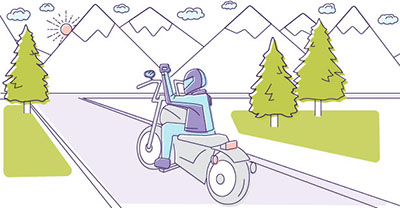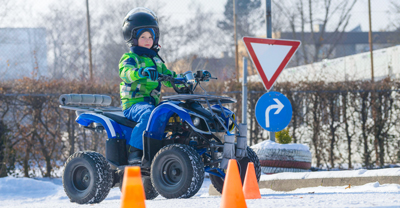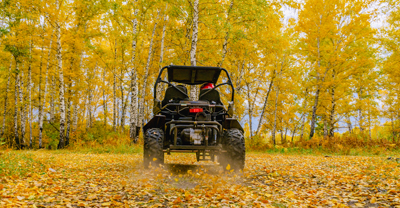Off-roading hand signals and trail etiquette
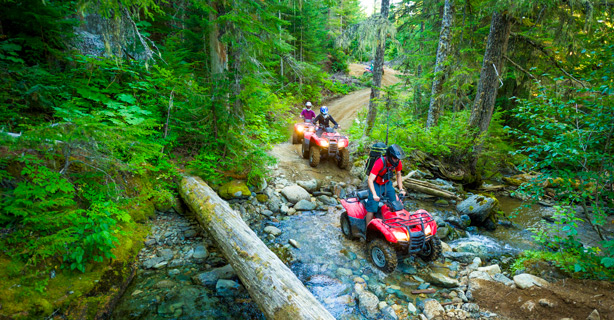
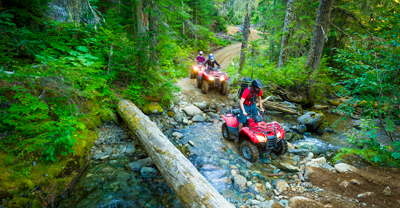
0 min. read
Are you ready to experience the thrill of an off-roading adventure? Before you rev up, it's essential to learn the unspoken language of the off-road community. In this guide, we’ll cover key hand signals and trail etiquette tips to help keep you safe and ensure everyone enjoys the ride.

Get a free off-road insurance quote today.
Why hand signals matter
In off-roading, your usual means of communication might fall short. Engine noise, distance, and lack of cell service can make it difficult to convey important information verbally. That’s where hand signals become invaluable. These universal signals enable off-roaders to communicate quickly, clearly, and effectively with other drivers.
Essential off-roading hand signals
Safe off-roading relies on clear coordination. Hand signals are fairly universal, so even new riders can recognize basics like stop, slow, and obstacle. Practicing with your group builds confidence, especially for challenging trails.
1. Stop

Signal: Raise left arm toward the sky with a closed fist facing forward
Meaning: Halt immediately
2. Go

Signal: Point your arm forward in the direction you want the group to move
Meaning: Proceed forward
3. Come

Signal: Point your arm towards yourself, motioning for the group to come closer
Meaning: Proceed closer
4. Slow down

Signal: Arm extended perpendicular to your body, palm facing down, moving up and down
Meaning: Reduce your speed
5. Speed up

Signal: Arm extended perpendicular to your body, palm facing up, moving up and down
Meaning: Increase your speed
6. Turn left/right

Signal: Arm extended straight out to the left or right
Meaning: Indicates the direction to turn
7. Oncoming vehicle

Signal: Arm raised toward the sky, palm facing forward, fingers spread
Meaning: Warning of an approaching vehicle
8. Obstacle ahead

Signal: Point to the ground where the hazard lies
Meaning: Warning of an obstacle, like a large rock or fallen tree
9. Last vehicle in line

Signal: Arm extended high with thumb up
Meaning: Indicates to riders outside your group that you’re the last in the group
Adapting communication for group riding
Hand signals are crucial for communication while off-roading, but certain situations may require different approaches when riding in a group. Here’s what you should know to effectively adapt to certain circumstances:
Group-specific signals
Before setting out, check if your group has unique signals for specific situations. Core signals like stop and slow down are common, but some groups use special shorthand for certain trail scenarios.
Mirror communication
Mirrors help riders at the front monitor those behind them, especially where hand signals are hard to spot. While they don’t replace signals, mirrors add extra awareness for group cohesion.
Night riding adaptations
Hand signals are tough to see at night, so riders often use brief light flashes. Flashing headlights or tapping brake lights can signal stop or slow down.
Pace signals
Some groups use gestures to adjust group speed. A “patting the air” motion can slow everyone down, while a forward thumbs-up signals the group to speed up.

Trail etiquette: The unwritten rules of off-roading
Now that we’ve covered hand signals, let’s talk about trail etiquette. Following these guidelines can create a positive experience for everyone on the trail.
Respect the environment

Off-roading is all about enjoying nature, so it’s our responsibility to help protect it. Here’s how to minimize your impact:
Stay on designated trails
Pack out what you pack in
Avoid disturbing wildlife
Use established campsites and fire rings when available
Limit noise pollution, especially around wildlife areas
Yield to others

Just like on the road, trails have a right-of-way hierarchy. Remember to:
Yield to uphill traffic, which has the right of way over downhill traffic
Allow larger, less maneuverable vehicles (like 4x4s) to go ahead of smaller, more agile vehicles
Give right of way to hikers and bikers
Be prepared

Nothing ruins a day on the trails faster than being unprepared. Here’s what to pack to help ensure a safe and comfortable trip:
Essential recovery gear (winch, tow straps, etc.)
Water and snacks
First-aid kit
Reliable communication for emergencies (satellite phone or radio)
Detailed map and a compass (don’t rely solely on GPS)
Sunscreen and bug spray
Drive responsibly

Off-roading can be thrilling, but safety should always come first. Make sure to:
Know your vehicle’s capabilities and limitations
Follow posted speed signs—and, if there are none, drive at a speed matching the terrain and conditions
Use a spotter when navigating tough obstacles
Never drink and drive (yes, this applies to off-roading, too!)
Be courteous to others

Kindness goes a long way on the trails. To maintain a friendly environment:
Minimize dust when passing other vehicles
Use headlights in low-visibility conditions
Offer help to fellow off-roaders in need
Keep noise levels reasonable, especially in populated areas
The off-roading community: We’re all in this together
One of the best things about off-roading is the camaraderie it brings. By following these hand signals and etiquette guidelines, you’re not only helping yourself and your fellow riders stay safe, you’re also contributing to a positive experience for everyone on the trails.
Ready for adventure?
Now that you’re familiar with off-roading hand signals and trail etiquette, you’re ready for your next adventure. Whether you ride ATVs, UTVs, dirt bikes, or snowmobiles, protecting yourself and your vehicle with off-road insurance is worth it. At Dairyland®, a brand of the Sentry Insurance Group, we understand riders like you and offer coverage that lets you ride with confidence.

Get a free off-road vehicle insurance quote today.
Related resources
The general information in this blog is for informational or entertainment purposes only. View our blog disclaimer.








